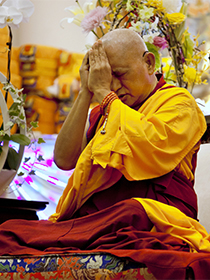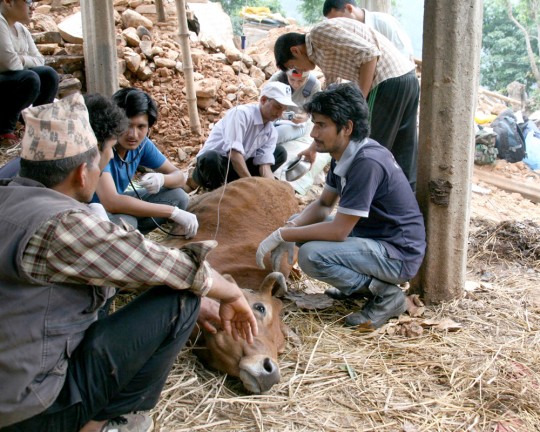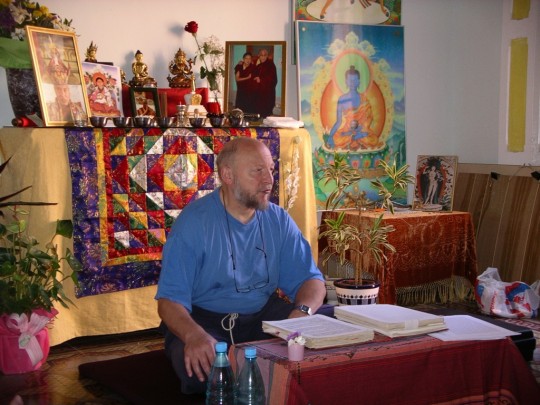- Home
- FPMT Homepage
Foundation for the Preservation of the Mahayana Tradition
The FPMT is an organization devoted to preserving and spreading Mahayana Buddhism worldwide by creating opportunities to listen, reflect, meditate, practice and actualize the unmistaken teachings of the Buddha and based on that experience spreading the Dharma to sentient beings. We provide integrated education through which people’s minds and hearts can be transformed into their highest potential for the benefit of others, inspired by an attitude of universal responsibility and service. We are committed to creating harmonious environments and helping all beings develop their full potential of infinite wisdom and compassion. Our organization is based on the Buddhist tradition of Lama Tsongkhapa of Tibet as taught to us by our founders Lama Thubten Yeshe and Lama Thubten Zopa Rinpoche.
- Willkommen
Die Stiftung zur Erhaltung der Mahayana Tradition (FPMT) ist eine Organisation, die sich weltweit für die Erhaltung und Verbreitung des Mahayana-Buddhismus einsetzt, indem sie Möglichkeiten schafft, den makellosen Lehren des Buddha zuzuhören, über sie zur reflektieren und zu meditieren und auf der Grundlage dieser Erfahrung das Dharma unter den Lebewesen zu verbreiten.
Wir bieten integrierte Schulungswege an, durch denen der Geist und das Herz der Menschen in ihr höchstes Potential verwandelt werden zum Wohl der anderen – inspiriert durch eine Haltung der universellen Verantwortung und dem Wunsch zu dienen. Wir haben uns verpflichtet, harmonische Umgebungen zu schaffen und allen Wesen zu helfen, ihr volles Potenzial unendlicher Weisheit und grenzenlosen Mitgefühls zu verwirklichen.
Unsere Organisation basiert auf der buddhistischen Tradition von Lama Tsongkhapa von Tibet, so wie sie uns von unseren Gründern Lama Thubten Yeshe und Lama Thubten Zopa Rinpoche gelehrt wird.
- Bienvenidos
La Fundación para la preservación de la tradición Mahayana (FPMT) es una organización que se dedica a preservar y difundir el budismo Mahayana en todo el mundo, creando oportunidades para escuchar, reflexionar, meditar, practicar y actualizar las enseñanzas inconfundibles de Buda y en base a esa experiencia difundir el Dharma a los seres.
Proporcionamos una educación integrada a través de la cual las mentes y los corazones de las personas se pueden transformar en su mayor potencial para el beneficio de los demás, inspirados por una actitud de responsabilidad y servicio universales. Estamos comprometidos a crear ambientes armoniosos y ayudar a todos los seres a desarrollar todo su potencial de infinita sabiduría y compasión.
Nuestra organización se basa en la tradición budista de Lama Tsongkhapa del Tíbet como nos lo enseñaron nuestros fundadores Lama Thubten Yeshe y Lama Zopa Rinpoche.
A continuación puede ver una lista de los centros y sus páginas web en su lengua preferida.
- Bienvenue
L’organisation de la FPMT a pour vocation la préservation et la diffusion du bouddhisme du mahayana dans le monde entier. Elle offre l’opportunité d’écouter, de réfléchir, de méditer, de pratiquer et de réaliser les enseignements excellents du Bouddha, pour ensuite transmettre le Dharma à tous les êtres. Nous proposons une formation intégrée grâce à laquelle le cœur et l’esprit de chacun peuvent accomplir leur potentiel le plus élevé pour le bien d’autrui, inspirés par le sens du service et une responsabilité universelle. Nous nous engageons à créer un environnement harmonieux et à aider tous les êtres à épanouir leur potentiel illimité de compassion et de sagesse. Notre organisation s’appuie sur la tradition guéloukpa de Lama Tsongkhapa du Tibet, telle qu’elle a été enseignée par nos fondateurs Lama Thoubtèn Yéshé et Lama Zopa Rinpoché.
Visitez le site de notre Editions Mahayana pour les traductions, conseils et nouvelles du Bureau international en français.
Voici une liste de centres et de leurs sites dans votre langue préférée
- Benvenuto
L’FPMT è un organizzazione il cui scopo è preservare e diffondere il Buddhismo Mahayana nel mondo, creando occasioni di ascolto, riflessione, meditazione e pratica dei perfetti insegnamenti del Buddha, al fine di attualizzare e diffondere il Dharma fra tutti gli esseri senzienti.
Offriamo un’educazione integrata, che può trasformare la mente e i cuori delle persone nel loro massimo potenziale, per il beneficio di tutti gli esseri, ispirati da un’attitudine di responsabilità universale e di servizio.
Il nostro obiettivo è quello di creare contesti armoniosi e aiutare tutti gli esseri a sviluppare in modo completo le proprie potenzialità di infinita saggezza e compassione.
La nostra organizzazione si basa sulla tradizione buddhista di Lama Tsongkhapa del Tibet, così come ci è stata insegnata dai nostri fondatori Lama Thubten Yeshe e Lama Zopa Rinpoche.
Di seguito potete trovare un elenco dei centri e dei loro siti nella lingua da voi prescelta.
- 欢迎 / 歡迎
简体中文
“护持大乘法脉基金会”( 英文简称:FPMT。全名:Foundation for the Preservation of the Mahayana Tradition) 是一个致力于护持和弘扬大乘佛法的国际佛教组织。我们提供听闻,思维,禅修,修行和实证佛陀无误教法的机会,以便让一切众生都能够享受佛法的指引和滋润。
我们全力创造和谐融洽的环境, 为人们提供解行并重的完整佛法教育,以便启发内在的环宇悲心及责任心,并开发内心所蕴藏的巨大潜能 — 无限的智慧与悲心 — 以便利益和服务一切有情。
FPMT的创办人是图腾耶喜喇嘛和喇嘛梭巴仁波切。我们所修习的是由两位上师所教导的,西藏喀巴大师的佛法传承。
繁體中文
護持大乘法脈基金會”( 英文簡稱:FPMT。全名:Found
ation for the Preservation of the Mahayana Tradition ) 是一個致力於護持和弘揚大乘佛法的國際佛教組織。我們提供聽聞, 思維,禪修,修行和實證佛陀無誤教法的機會,以便讓一切眾生都能 夠享受佛法的指引和滋潤。 我們全力創造和諧融洽的環境,
為人們提供解行並重的完整佛法教育,以便啟發內在的環宇悲心及責 任心,並開發內心所蘊藏的巨大潛能 — 無限的智慧與悲心 – – 以便利益和服務一切有情。 FPMT的創辦人是圖騰耶喜喇嘛和喇嘛梭巴仁波切。
我們所修習的是由兩位上師所教導的,西藏喀巴大師的佛法傳承。 察看道场信息:
- FPMT Homepage
- News/Media
-
- Study & Practice
-
-
- About FPMT Education Services
- Latest News
- Programs
- New to Buddhism?
- Buddhist Mind Science: Activating Your Potential
- Heart Advice for Death and Dying
- Discovering Buddhism
- Living in the Path
- Exploring Buddhism
- FPMT Basic Program
- FPMT Masters Program
- FPMT In-Depth Meditation Training
- Maitripa College
- Lotsawa Rinchen Zangpo Translator Program
- Universal Education for Compassion & Wisdom
- Online Learning Center
-
- Prayers & Practice Materials
- Overview of Prayers & Practices
- Full Catalogue of Prayers & Practice Materials
- Explore Popular Topics
- Benefiting Animals
- Chenrezig Resources
- Death & Dying Resources
- Lama Chopa (Guru Puja)
- Lama Zopa Rinpoche: Compendium of Precious Instructions
- Lama Zopa Rinpoche: Life Practice Advice
- Lama Zopa Rinpoche Practice Series
- Lamrim Resources
- Mantras
- Prayer Book Updates
- Purification Practices
- Sutras
- Thought Transformation (Lojong)
- Audio Materials
- Dharma Dates - Tibetan Calendar
- Translation Services
- Publishing Services
- Ways to Offer Support
- Prayers & Practice Materials
-
- Teachings and Advice
- Find Teachings and Advice
- Lama Zopa Rinpoche Advice Page
- Lama Zopa Rinpoche: Compendium of Precious Instructions
- Lama Zopa Rinpoche Video Teachings
- ༧སྐྱབས་རྗེ་བཟོད་པ་རིན་པོ་ཆེ་མཆོག་ནས་སྩལ་བའི་བཀའ་སློབ་བརྙན་འཕྲིན།
- Podcasts
- Lama Yeshe Wisdom Archive
- Buddhism FAQ
- Dharma for Young People
- Resources on Holy Objects
- Teachings and Advice
-
-
*If a menu item has a submenu clicking once will expand the menu clicking twice will open the page.
-
-
- Centers
-
- Teachers
-
- Projects
-
-
-
-
*If a menu item has a submenu clicking once will expand the menu clicking twice will open the page.
-
-
- FPMT
-
-
-
-
-
Actions that give harm to other sentient beings aren’t those of a bodhisattva. In Buddhism, there’s no such thing as a holy war. You have to understand this. It’s impossible to equalize everybody on earth through force.
Lama Thubten Yeshe
-
-
-
- Shop
-
-
-
The Foundation Store is FPMT’s online shop and features a vast selection of Buddhist study and practice materials written or recommended by our lineage gurus. These items include homestudy programs, prayers and practices in PDF or eBook format, materials for children, and other resources to support practitioners.
Items displayed in the shop are made available for Dharma practice and educational purposes, and never for the purpose of profiting from their sale. Please read FPMT Foundation Store Policy Regarding Dharma Items for more information.
-
-
Mandala
30
How to Bless Water

Lama Zopa Rinpoche commissioned a Padmasambhava crystal to help bless water, March 2013. Photo courtesy of Murray Wright.
In the online content for Mandala July-September 2013, FPMT student Murray Wright describes the story of how he and friends Ven. Tenzin Chogkyi and Brian Rae offered holy crystals to bless the waters of New Zealand’s North Island during the worst New Zealand drought in 65 years.
“To benefit people in Bodhgaya, Lama Zopa Rinpoche commissioned glass crystals engraved with a special mantra of Guru Padmasambhava,” Murray writes. “Due to Padmasambhava’s stainless prayers impregnated with bodhichitta and wisdom, the minds of those drinking water touched by the mantra are blessed. Veteran stupa builder Tom Waggoner brought the crystals when he visited in 2011. We offered them into several large reservoirs around Auckland. An enthusiast of holy objects he said, ‘Wow, it’s so easy to create merit with these crystals. All you have to do is place them in the water!’ He urged me to ‘get some inventory’ from the FPMT Foundation Store to offer more.
“In February, Brian and I had a powerful experience on an extremely hot day doing just that. As we approached our third site, Brian felt a migraine coming. These headaches, which had dogged him since youth, begin with blurred vision. At the dam-site, when launched towards the water, the crystal struck a barrier and shattered on rocks below. Dejected, we offered the shards in the water. Returning with another, we chanted the crystal’s mantra while marching 400 meters [1,312 feet] from the car up to the dam. At the top, Brian’s vision became extremely clear – crystal clear – and the headache never materialized. Unusually-shaped clouds were seen.” Read more …
The mantra etched in glass is available through the Foundation Store. Lama Zopa Rinpoche has mentioned that the glass can be respectfully stored in containers for drinking water given to humans and animals (see store site for details).
- Tagged: food, foundation store
- 0
3
Animal Welfare in Nepal after the Earthquake
World Animal Day is celebrated every year on October 4. In honor of the day, Mandala has published a new online feature story, “Animal Welfare in the Aftermath of the 2015 Nepal Earthquake,” by Phil Hunt and Tania Duratovic, coordinators for Enlightenment for the Dear Animals and for the Animal Liberation Sanctuary, a project of Kopan Monastery. Phil and Tania report on the conditions many animals faced after the devastating earthquake. They write:
“When disasters strike, the first response is naturally to search for and rescue people. Animals are often forgotten in the chaos even though they are often injured and in desperate need of food, shelter and medical attention. Getting help for animals in a disaster is a challenge, but it can benefit the entire community as well as the animals themselves. …” (Read the entire article here.)
You can also read updates from Nepal on the amazing work of the monks and nuns of Kopan Monastery, who formed Kopan Helping Hands and were immediately offering assistance to thousands of earthquake-affected people. For more see FPMT Charitable Projects blog posts.
FPMT.org brings you news of Lama Zopa Rinpoche and of activities, teachings and events from nearly 160 FPMT centers, projects and services around the globe. If you like what you read, consider becoming a Friend of FPMT, which supports our work.
17
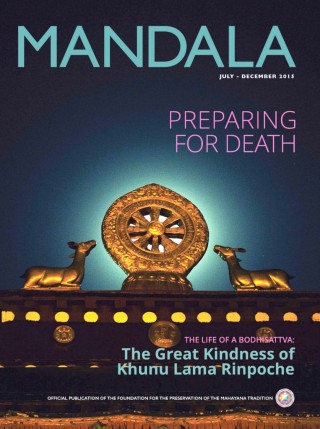
COVER PHOTO: The full moon behind the Dharma wheel and deer above the entrance of Lhasa’s Jokhang Temple, Tibet, 2014. Photo by Matt Lindén.
The new, redesigned Mandala magazine is in the mail to supporters of the Friends of FPMT program and students who receive Mandala through FPMT centers and projects that offer it to supporters as a benefit.
With our reimagining of Mandala we hope we have created a timeless print publication that will inspire FPMT students and help them strengthen their practice of Dharma.
In this issue, learn about the importance of death awareness practice and of knowing how to enjoy death as taught by Lama Yeshe and Lama Zopa Rinpoche. Also featured, the biography of the great Buddhist master Khunu Lama Rinpoche; Ven. Robina Courtin writes about the creation of Lama Zopa Rinpoche’s book How to Enjoy Death; an interview with Tibetan Buddhist scholar Elijah Ary; and we remember Dharma pioneer Ven. Ann McNeil; plus much more.
In addition to the print issue, we’ve published several online-only pieces, including a new advice on practicing patience by Lama Zopa Rinpoche, an interview with Buddhist scholar Anne Klein and “The Life of Khensur Jampa Tegchok” by Ven. Steve Carlier. For this and more, see Mandala July-December 2015.
Mandala is offered as a benefit to supporters of the Friends of FPMT program, which provides funding for the educational, charitable and online work of FPMT.
The new issue is available through the FPMT Foundation Store.
16
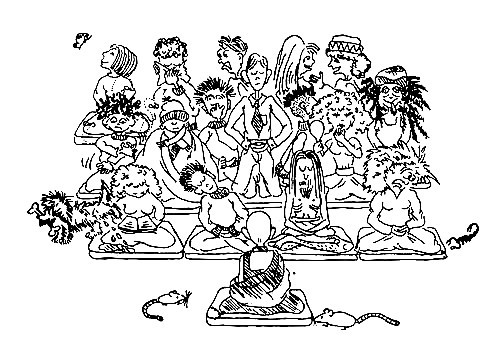
Artwork by Ven. Tsapel
By Ven. Chönyi Taylor
With the launch of the new, redesigned Mandala today, we are happy to share the most recent Dharma Realities column by Ven. Chönyi Taylor, who has been contributing to Mandala‘s online edition since 2010.
Positive psychology is about dreams. Our New Millennium version is a dream of unending health, vitality and, hopefully, lots of money. Our New Millennium dreams may be different in content from other times, but not intention: we want to be happy.
There is a long history to positive psychology, dating at least back to the Greek philosophers. Epicurus had the idea that our life should be happy, tranquil, peaceful and free from fear. We should not experience pain and we should be able to manage our own lives within the company of friends. This has been updated by Martin Seligman in his description of positive psychology:
“The good life consists in deriving happiness by using your signature strengths every day in the main realms of living. The meaningful life adds one more component: using these same strengths to forward knowledge, power or goodness.”
Positive thinking as an antidote to unhappiness and dissatisfaction is not new. In 1952, Norman Vincent Peale wrote The Power of Positive Thinking. Back then, being happy meant being born into a white, middle-class, nuclear family. It was the start of a massive rise in advertising on the heels of radio, TV and films. Happiness was also defined by possessions: a car, refrigerator, washing machine and vacuum cleaner, things that became essential household items. It was an unrealistic dream. It was a 1950s version of positive psychology. You can make it work, and if you don’t, then you are a failure.
The storybook characters Jane and Dick taught me to read, and for my four-year-old self, they were the example of what children and family should be, of what my family should be. The stereotype, of course, was rarely realized. My mother tried her best to live it out, but we kids and my father’s health, constantly undermined her efforts. The stereotype was a 1950s version of what positive psychology would generate. Unfortunately, our family did not meet the criteria. My mother was a fan of Norman Vincent Peale. She was not often happy.
Trends in psychology come and go. We have had post-Freudian psychology, existential psychology, humanistic psychology, gestalt, being-psychology, transpersonal psychology, hypnosis and mindfulness in the last 50 years. Each of them promised the good life. The latest one is positive psychology.
The Buddhist version of the good life is quite different. The path to happiness is realized through the four noble truths. Suffering is not denied, it is recognized as an integral part of our ordinary lives (the first truth). Suffering arises from ignorance, grasping, clinging as described the twelve links of cyclic existence, all of which generate a mind habituated to these thoughts (karma and the second noble truth). Yes, there is an end to our suffering (the third noble truth), but it requires a lot of hard work (the fourth noble truth) and the development of the six perfections: generosity, patience, courage (enthusiasm), concentration (deep meditation) and enough wisdom to really understand how we misinterpret reality.
There is no mention of “signature strengths” or “power.” Instead, we have the six perfections of the bodhisattva. Knowledge has a much deeper meaning than Seligman’s concept of intellectual advances, since it includes the profound wisdom realizing emptiness. And “goodness” is no vague concept, but anything which does not harm others.

Kopan Monastery monks help distribute drinking water, Kathmandu, Nepal, April 2015. Photo via Facbook, Kopan Monastery School.
A positive life is represented here by the Kopan monks helping out after the Nepal earthquake. They do not seem to be concerned about signature strengths, or about power or goodness. They are not blissed out or self-centred; they are not striving for “the happy life.”
The good life can be painful.
Ven. Chönyi Taylor is a registered Foundational Buddhism FPMT teacher and an elder for the Discovering Buddhism at Home Course. She is the author of Enough! A Buddhist Approach to Working with Addictive Patterns (Snow Lion, 2010) and has been published in Mandala, Buddhadharma, Dharma Vision and Sangha Magazine. She is a founding member and member of the training committee of the Australian Association of Buddhist Counsellors and Psychotherapists and an Honorary Lecturer in the Discipline of Psychiatry at Sydney University.
- Tagged: psychology, ven. chonyi taylor
- 0
15
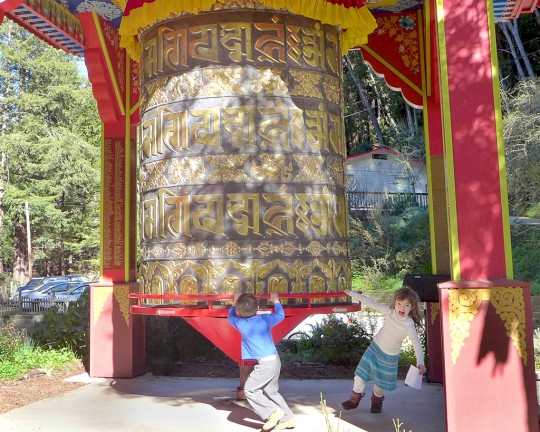
Prayer wheel with 64 billion OM MANI PADME HUM mantras at Land of Medicine Buddha, California, US, January 2015. Photo by Laura Miller.
When someone tells you a prayer wheel contains so many millions or billions of mantras, do you ever stop and think, “How can they all fit in there?”
In the latest online feature from Mandala, Donna Lynn Brown shares the inside story on printing mantras on microfilm, which is not quite as simple as it sounds. FPMT student Tai Vautier, working with FPMT Education Services, has been involved for many years making high quality microfilm mantras accessible to Dharma students. Here’s an excerpt from the story:
“… Getting as many mantras as possible on the film, while keeping them legible, was Tai’s aim. At first, using an old Ditto machine, she copied mantras from Lorne Ladner’s book, Wheel of Great Compassion: The Practice of the Prayer Wheel in Tibetan Buddhism, but shrinking made these illegible. She then got the original of one set of Lorne’s mantras, which had come from the office of His Holiness the Dalai Lama. This she scanned and edited in Photoshop. She managed to get an astonishing 880,000,000 manis onto a 2,000-foot (610-meter) roll of microfilm. But although the mantra remained readable, the master, due to the shape of the Tibetan letters, was too fragile to withstand the constant duplication needed to fill large orders. While this master is still available for small jobs, a sturdier one was needed. Tai worked long hours in Photoshop to thicken some parts of the Tibetan letters and spread others apart, in effect designing her own font in order to create mantras that were readable after reduction, and didn’t cause the film to weaken with heavy use. …”
The microfilm printed from master copies that Tai helped create fills prayer wheels and stupas all over the world. Read more in “The Inside Story: Microfilm, Holy Objects, and the Passion of Tai Vautier.”
More information on mantra microfilm, including ways to order it for stupas and statues is made available by FPMT Education Services on FPMT.org.
- Tagged: education news
- 0
24
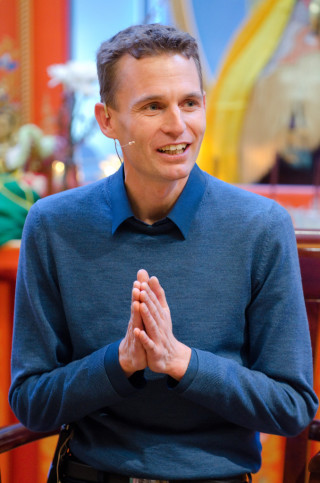
Rasmus Hougaard, Maitripa College, Portland, Oregon, US, February 2015. Photo by Marc Sakamoto.
Rasmus Hougaard is the founder and managing director of the Potential Project, an international program based in Copenhagen, Denmark, that works with corporations and organizations to equip their leaders and employees with methods to be more more kind, clear-minded, focused and efficient. Mandala managing editor Laura Miller talked with Rasmus in February 2015, during a visit to Maitripa College in Portland, Oregon, US.
“I think there are two things that should always be there in mindfulness: one is the ethical component and the other one is the compassionate component,” Rasmus said. “Without those two, I think you have lost the essence of mindfulness. Our presentation of mindfulness is coming from Buddhism. You can’t take away from that, and you can’t disregard all of the masters of the past that have said that mindfulness, ethics and compassion go hand-in-hand. You can’t have real mindfulness without having compassion. So it is a big part of our program, although not obviously. We don’t tell our clients, ‘We teach compassion in our ethical program,’ because they would never engage with us. We tell them instead that we are coming with a mindfulness program that will make their employees more effective, more calm, more kind, and then we introduce ideas of compassion once we’re in the door.”
Read the complete interview as part of Mandala‘s March online feature.
In case you missed last month’s online feature, “Memorization: Beneficial Exercise for the Mind,” you can read it now. You can also still take a look at January’s online feature: “Jeffrey Hopkins’ Transmission of Honesty.”
If you like Mandala’s online features, consider becoming a Friend of FPMT, which supports our work as well as the education programs of FPMT.
- Tagged: foundation for developing compassion and wisdom, potential project, rasmus hougaard, universal education
- 0
22
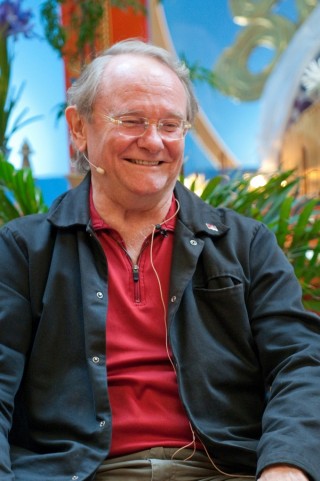
Professor Jeffrey Hopkins, Maitripa College, Portland, Oregon, United States, September 2011. Photo by Marc Sakamoto.
Dr. Jeffrey Hopkins, now 74, is professor emeritus at the University of Virginia and one of the world’s top scholars of Buddhism. He has published 42 books, acted as His Holiness the Dalai Lama’s translator, and had a long academic career during which he trained many prominent Tibetan Buddhist scholars and translators. He currently leads UMA Institute for Tibetan Studies. Dr. Hopkins has been remarkably open in public about a wide range of matters, such as his initial lack of faith in His Holiness, past-life memories, a near-death experience, his youthful delinquency, his sexuality, and so on.
Donna Lynn Brown interviewed him in December 2014 to find out what lessons his honesty might hold for other Buddhist practitioners.
Dr. Hopkins, what is the source of your frankness? Why are you so open?
I was born in 1940 in Barrington, Rhode Island, and I was in my teens in the 1950s. There was a group of us who were disgusted by the aims that were being presented to us: merely making money and so forth. There was a lot of rebellion that was focused against the dishonesty of society, which gradually in my own mind became a matter of seeking my own integrity. My own integrity meant a great deal to me.
I was part of a juvenile gang that got into difficulty with the law, in the sense of increasingly violent pranks, drinking and so forth. It was a relief when I went to a liberal prep school where students were given a great deal of responsibility for their own governance. Despite all my acting out at my public school, I responded very well in that kind of environment, and got excellent grades, because we were respected as people, which is something I had lacked prior to that. Then, in my first year at Harvard, I read Walden by Henry David Thoreau and I was inspired to leave Harvard for the woods of Vermont. I stayed in a small one-room cabin and read, wrote poetry, walked a lot, dreamt out my recurrent trapped dreams, and I believe at that point, began finding my own integrity. And I kept returning to that kind of life.
I was inspired by Herman Melville’s novel Typee, which is set in the Marquesas, north of Tahiti near the equator, and Somerset Maugham’s The Moon and Sixpence about the artist Paul Gauguin, who painted in the South Seas. It was 1960 and when Vermont got too cold for the wood heater, I went to the woods in Rhode Island. When that got too cold, I shipped out of New York as a passenger on a freighter to Tahiti. I had gotten used to meditating in Vermont on the lake that was down below, and by gazing off into space. On the freighter I would lie on my back and stare upward, filling my mind with the blueness of the sky. The Pacific Ocean was clean and tremendously calm and I filled my mind with that. I didn’t have a visa for Tahiti and after a while some official noticed this and asked me to leave. I used all but my last $15 to take a seaplane to Hawaii. It was nuts, but it was a search for my own integrity.
11
Technology and Mindfulness
By Ven. Chönyi Taylor
There was a time when I nearly killed myself, but for the attentiveness of the driver of the car coming towards me. I was so absorbed in a problem I was trying to solve that I was totally unaware of where I was, that is, that I was crossing the road. This was well before the days of mobile phones. Now the ubiquitous phones appear to be responsible for many more people putting themselves in danger through the same lack of awareness of surroundings. They, like me, are being intensely mindful. But, something is not quite right. It must be the technology.
New technology tends to have a bad press. Once we were warned against the act of writing, the new technology of the early Greeks. Socrates thought that writing would create forgetfulness because people would not use their memories. I doubt whether this is the earliest example of “inattention blindness,” also known as “lack of mindfulness.” How often did our Stone Age ancestors lose their prey through inattentiveness? Certainly we know that hunters need to be both patient and alert at the same time. Writing is, and was, nothing more than a different form of attentiveness. It may or may not assist our memory skills, but the world has not fallen apart because we can write.
Then we were warned about reading books. This was not a big problem before the breakthrough technology of the printing press. Now anyone could read so long as they had been taught the alphabet and phonetics. It is the cornerstone of primary education.
There is the wonderful story of the 15th-century Luddite, abbot Johannes Trithemius, who was no fan of the printing press, because he thought that the printing press would make monks lazy.1 Copying meant that you worked hard, which was better for the soul than just reading. He also thought that this newfangled printed book was not as nice as the old copied book. That reminds me of the arguments against ebooks: they just are not as nice as the old paper books and they do not smell the same.
Now it is the rise of the internet and the mobile phone which is going to make a mess of our brains, according to Nick Carr in the Wall Street Journal. The problem is division of attention, which becomes locked into our brains.2
Inattention. Also known as “lack of mindfulness.” Mindfulness, being good, implies that its opposite, inattention, is bad.
Take mobile phones, for example. They are also blamed for “inattention blindness.” People walk into cars, fall into ponds, and even kill others by texting while they are driving. We are warned about the ability of our phones to give us an illusion of connectedness while actually creating the opposite. This becomes locked into our brains.
What we seem to be sacrificing in all our surfing and searching is our capacity to engage in the quieter, attentive modes of thought that underpin contemplation, reflection and introspection. The web never encourages us to slow down. It keeps us in a state of perpetual mental locomotion.3
In other words, modern technology gives us new ways to be distracted.
Is this so?
Mindfulness necessarily creates inattention to whatever we are not being mindful of.
Inattention can also be called: concentration, distraction, inattentiveness, preoccupation, absent-mindedness, daydreaming, dreaminess, reverie, wool-gathering, abstraction, staring into space, obliviousness. Some of these synonyms are good and some are not. Where would we be without daydreaming, reverie, staring into space, brainstorming? These are also opposite to mindfulness. Studies of the creative process show that both daydreaming and attentiveness are required in the process of creation, but at different times. J. P. Guilford, the great psychologist, coined the terms “divergent thinking” and “convergent thinking.”4 We need both.
So, mindfulness which is being directed towards the phone screen is not being directed elsewhere. That does not mean we are incapable of being mindful, it only means that we have chosen to be mindful of one thing without thinking about the consequences. And having something “locked into our brains” is just current jargon for “learning.” Rather than being alarmed by these brain changes, it would be better to recognize that the neuro-circuits can also be unchanged. In other words, we create habits and we break them.
This is true, too, of our Buddhist practices. We can develop mindfulness as an aspect of meditation and as we do that we are inattentive to any problems happening around us. Meditation, wisely, can be single-pointed concentration (convergent thinking) or analytical meditation (divergent thinking). Post meditation is the time for creating merit that is to generate deeper and wiser states of mind, of wisdom and of compassion. Creating merit also requires both convergent and divergent thinking. How can I benefit this sentient being, the mouse and its decidedly unhealthy droppings? Divergent thinking. I want to do this without killing the mouse. How can I trap it without killing it? Ah, here is an idea that might work. Let me put it into practice. Convergent thinking. Both these states are necessary if the meditation or the creation of merit is to be successful.
What really matters is not attentiveness, or even short burst thinking, but the wisdom which realizes we are not paying attention to what really matters at any one time.
Then, of course, there is our motivation that turns everyday activity into Dharma practice. But that is another topic.
Ven. Chönyi Taylor is a registered Foundational Buddhism FPMT teacher and an elder for the Discovering Buddhism at Home Course. She is the author of Enough! A Buddhist Approach to Working with Addictive Patterns (Snow Lion, 2010) and has been published in Mandala, Buddhadharma, Dharma Vision and Sangha Magazine. She is a founding member and member of the training committee of the Australian Association of Buddhist Counsellors and Psychotherapists and an Honorary Lecturer in the Discipline of Psychiatry at Sydney University.
1. Mike Masnick, “A Fifteenth Century Technopanic About The Horrors Of The Printing Press,” Techdirt.com, February 25, 2011 <https://www.techdirt.com/articles/20110119/05022912725/fifteenth-century-technopanic-about-horrors-printing-press.shtml>
2. Nick Carr, The Shallows: What the Internet is Doing to our Brains, W.W. Norton & Co., 2011
3. Nick Carr, “Does the Internet Make You Dumber?” Wall Street Journal, June 5, 2010 <http://online.wsj.com/articles/SB10001424052748704025304575284981644790098>
4. J. P. Guilford, The Nature of Human Intelligence, McGraw-Hill, New York, 1967
- Tagged: mindfulness, ven. chonyi taylor
- 0
16
In September 2014 during the CPMT 2014 meeting, managing editor Laura Miller met with student Françoise Majeste who revealed that a close student of Lama Yeshe and a long-time student of Institut Vajra Yogini in France – Jacques Haesaert – had died over five years ago, but had never been honored in Mandala. We’re happy to now share this tribute to Jacques’ life from his friends and students.
Jacques Haesaert, 67, died in Graulhet, France, July 2009, from a stroke
By Marilyn Magazin and Brigitte Jordan on behalf of the members of the Ambroisie Association
Five years have gone by since our doctor, teacher and friend, Jacques Haesaert, passed on. When he died in July 2009 at the age of 67, we were so unprepared and perturbed that none of his many students in France and Spain thought to send an obituary to Mandala magazine. Jacques was a member of Institut Vajra Yogini in Marzens, France and benefited not only his patients, but also his many students who came to his introductory classes on Tibetan medicine at the institute and his in-depth study programs. Now in remembrance of him, we write this biography as a tribute to him and his work.
Jacques Haesaert was passionate about learning and taught himself to read even before starting school in France. His personal studies of biology, natural medicine, the powers of plants and minerals, archeology, religions, Egyptology, cooking, music, to name a few, surely helped him assimilate Tibetan medicine later on. As well as working in France, Jacques spent many years in Africa and later worked in the Phillipines with local healers.
In 1974, his spiritual search brought him to India where he had his first contact with Tibetan Buddhist philosophy and the medicine practiced in this country. In Nepal he became a disciple of Lama Thubten Yeshe who encouraged him to study Tibetan medicine. Jacques followed Lama’s advice and studied many years in Dharamsala, India with Dr. Ama Lobsang Dolma.
We do not know all the details of his many years of study, treating and accompanying patients in India as a Tibetan doctor, but we do know that he also studied with Dr. Tsering Dinggang and worked for some time with the Missionaries of Charity of Mother Teresa in Calcutta, with the most destitute of people.
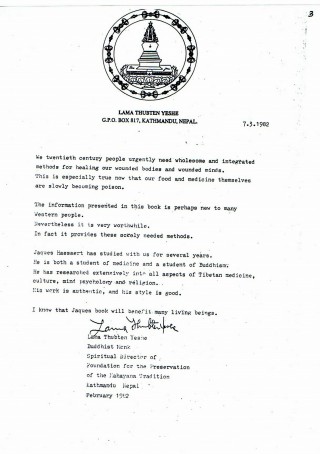
In this 1982 forward, Lama Yeshe praises Jacques’ work writing “Jaques [sic] Haesaert has studied with us for several years … He has researched extensively into all aspects of Tibetan medicine, culture, mind psychology and religion. His work is authentic, and his style is good.”
In 1981, Lama Yeshe asked Jacques to share his knowledge with the Western world in a way that was adapted to the special needs of the people living in those places in actual times. After returning to France, Jacques treated patients and taught for the rest of his life.
As well as a practicing Tibetan Buddhist, he was also a Christian and Bible scholar. Jacques often made parallels between passages in the Bible and teachings of Buddha.
Faithful to the ethics of a Tibetan physician, he expected no pay for his consultations, only accepting offerings. In his later years, he made only two appointments a day so he could remain for hours with each patient in order to treat the patient as a whole and help the person to understand the cause of his ailments, and not just treat his symptoms.
Jacques always intended to write a book so many people could benefit from the knowledge and wisdom he accumulated over so many years, applying Tibetan medicine to the West. He wanted to help Westerners discover the extraordinary and practical knowledge offered by this system. For him it was important to show, through Tibetan medicine, how people can become responsible for their mental and physical health, conscious of their potential for happiness, love and wisdom, and of the errors that would lead them to suffering.
Just months before passing on, after years of our begging for them, he gave to us, his students in France and Spain, his nearly finished book that he used for his classes. He compiled it over decades and organized the information into chapters used for his teaching. Jacques explains important teachings from the medical tantras and elaborates on many aspects of what is health and disease, diagnosis, prevention, and treatment. Moreover, he explains many aspects of Tibetan medicine from a Western point of view.
We, his students and members of the Ambroisie Association, are in the process of translating it from French to English, Spanish, and German. It was his heart-felt wish to help preserve the extensive knowledge and wisdom that is Tibetan medicine from being lost or diluted.
You can find Jacques’ piece “Nature the Great Healer” in the June 2004 issue of Mandala.
Lama Zopa Rinpoche requests that “students who read Mandala pray that the students whose obituaries they read find a perfect human body, meet a Mahayana guru and become enlightened quickly, or be born in a pure land where the teachings exist and they can become enlightened.” While reading obituaries we can also reflect upon our own death and rebirth, prompting us to live our lives in the most meaningful way.
More advice from Lama Zopa Ripoche on death and dying is available on Lama Zopa Rinpoche’s advice page.
- Tagged: france, institut vajra yogini, jacques haesaert, obituaries
- 0
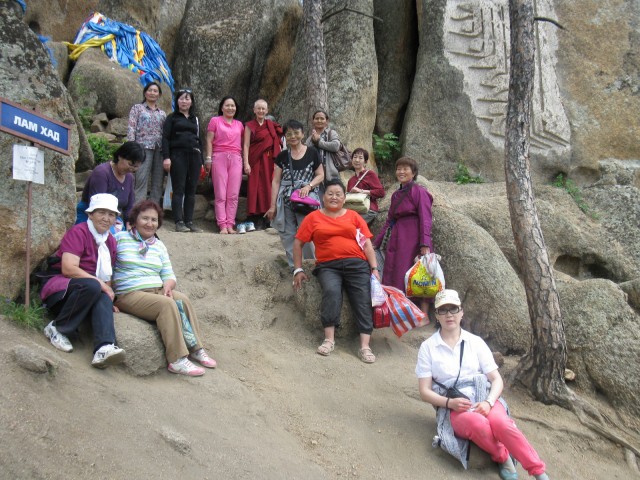
The students of Golden Light Sutra Center negotiated the terrain around Aglag Monastery with ease, Darkhan, Mongolia, July 2014. Photo courtesy of Ven. Tezin Tsapel.
Ven. Tenzin Tsapel, director of Golden Light Sutra Center in Darkhan, Mongolia, reports on the group’s celebration of His Holiness the Dalai Lama’s July 6, 2014 birthday:
A group Golden Light Sutra Center students went on a sutra reading picnic for His Holiness’ birthday celebration. We hired a mini-bus for the two-hour drive to Aglag Monastery, 13 kilometers (8 miles) off the Darkhan/Ulaanbaatar road. As we drove in, the valley became quite narrow, and heavily treed, very green and culminated in small, steep mountain with unusual natural rocky outcrops, enclosed by a ring of mountains. From the car park we walked up the step gravel drive to the main monastery and cluster of buildings. The center piece was an ornately painted monastery building with a commanding view.
We settled in to recite the Vajra Cutter Sutra in front of the central Amitabha altar and then joined the stream of visitors upstairs paying respect to the holy images and Buddha relics and viewing an odd assortment of mythical beast models.
The path led behind the main building and around a very beautiful but very steep and slippery mountain track past numerous carved holy images, mantras and syllables, as well as a few obstacle-course rock formations. My initial concern for some of the older members of our group gave way to respect as our hardy Mongolian ladies made their way around mountain. We stopped on the way for some birthday cake and fruit and made our way to the grass base for our late picnic lunch.
Mandala brings you news of Lama Zopa Rinpoche and of activities, teachings and events from over 160 FPMT centers, projects and services around the globe. If you like what you read on Mandala, consider becoming a Friend of FPMT, which supports our work.
- Tagged: golden light sutra center, mandala, mongolia
- 0
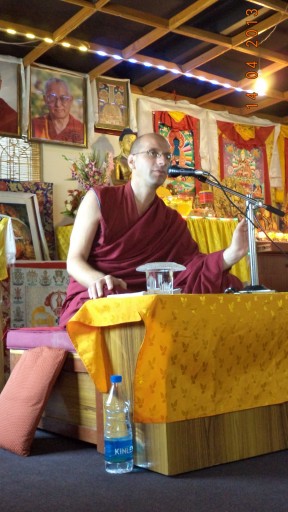
Ven. Tenzin Namdak teaching at Choe Khor Sum Ling, Bangalore, India, April 2013. Photo courtesy of Choe Khor Sum Ling.
“As part of the ongoing Discovering Buddhism course at Choe Khor Sum Ling, we recently organized a four-day non-residential retreat,” said center member Shanti Gopinath in an email to Mandala in July. “Under the adept guidance of Ven. Tenzin Legtsok from Sera Je, students reflected and meditated upon the outlines of two topics from the program: ’The Spiritual Teacher’ and ’Death and Rebirth.’ The meditation sessions invigorated all that we learned theoretically in these two modules. The retreats included reflection and guided meditation. Ven. Legtsok’s pragmatic approach to the reflection, contemplation and meditation process made the concepts easier to understand, clearer and deep seated in our minds.”
“Bangaloreans are mostly a staunch working community and so a non-residential retreat in the heart of the city was well received. Participants were happy to break away from everyday monotony and the distractions of ordinary life.
“Our next four-day residential retreat in August 2014 will be at Gyume Tantric Monastery in Hunsur. The retreat will be led by Ven. Tenzin Namdak from Sera Je. The retreat will incorporate guided meditations focused around the topics outlined in the Discovering Buddhism modules ‘All About Karma’ and ‘Refuge.’ Gyume Monastery is in a Tibetan farming settlement four hours’ drive from Bangalore and is a perfect setting for our next retreat.”
Mandala brings you news of Lama Zopa Rinpoche and of activities, teachings and events from over 160 FPMT centers, projects and services around the globe. If you like what you read on Mandala, consider becoming a Friend of FPMT, which supports our work.
- Tagged: choe khor sum ling, mandala
- 0
2
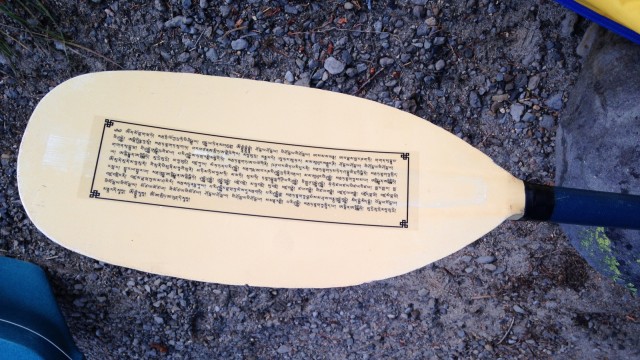
Kayak paddle with Namgyälma mantra, Waldo Lake, Oregon, US, August 2014. Photo courtesy of Mandala Publications.
A third-year Maitripa College student sent Mandala this idea on how to use the Namgyälma mantra to make kayaking a more beneficial experience. “The Namgyälma mantra is extremely powerful,” Lama Zopa Rinpoche teaches. “It is the main mantra to purify and liberate beings from the lower realms, purify negative karma, and help those who are dying or have died ….” Here is her account:
During a rituals and ethics class, we learned about water tsa-tsas. While kayaking one day, I started thinking about how many times my paddle was in the water. I wondered if there was a way to do something like the water tsa-tsas with my paddle.
I came across an article about Lama Zopa Rinpoche’s Namgyälma mantra board and blessing all the creatures in the water and whomever comes in contact with the water. I put two and two together and started asking around about a way to put a mantra on a kayak paddle.
The mantra that I used is actually a bumper sticker that I got through the FPMT Foundation Store. Before putting on the sticker, I first did the Jorchö practice and recited some of the mantras I found in the tsa-tsa book. Afterward, I dedicated the merit. Since it’s important to protect the mantra, I cover both of the paddle blades with stuff sacks for storage, taking them off before paddling and putting them back on when I’m done.
The new stickers have really changed the way I treat my paddles and my mindset while paddling. I recite a mantra most of the time as I paddle and dedicate at the end of the kayak outing.
The Foundation Store, managed by FPMT International Office, provides Dharma materials and supplies to interested students around the world. All proceeds from the shop are used to further the charitable mission of FPMT Inc.
Mandala brings you news of Lama Zopa Rinpoche and of activities, teachings and events from over 160 FPMT centers, projects and services around the globe. If you like what you read on Mandala, consider becoming a Friend of FPMT, which supports our work.
- Tagged: maitripa college, mandala, namgyalma mantra
- 0
- Home
- News/Media
- Study & Practice
- About FPMT Education Services
- Latest News
- Programs
- New to Buddhism?
- Buddhist Mind Science: Activating Your Potential
- Heart Advice for Death and Dying
- Discovering Buddhism
- Living in the Path
- Exploring Buddhism
- FPMT Basic Program
- FPMT Masters Program
- FPMT In-Depth Meditation Training
- Maitripa College
- Lotsawa Rinchen Zangpo Translator Program
- Universal Education for Compassion & Wisdom
- Online Learning Center
- Prayers & Practice Materials
- Overview of Prayers & Practices
- Full Catalogue of Prayers & Practice Materials
- Explore Popular Topics
- Benefiting Animals
- Chenrezig Resources
- Death & Dying Resources
- Lama Chopa (Guru Puja)
- Lama Zopa Rinpoche: Compendium of Precious Instructions
- Lama Zopa Rinpoche: Life Practice Advice
- Lama Zopa Rinpoche Practice Series
- Lamrim Resources
- Mantras
- Prayer Book Updates
- Purification Practices
- Sutras
- Thought Transformation (Lojong)
- Audio Materials
- Dharma Dates – Tibetan Calendar
- Translation Services
- Publishing Services
- Teachings and Advice
- Find Teachings and Advice
- Lama Zopa Rinpoche Advice Page
- Lama Zopa Rinpoche: Compendium of Precious Instructions
- Lama Zopa Rinpoche Video Teachings
- ༧སྐྱབས་རྗེ་བཟོད་པ་རིན་པོ་ཆེ་མཆོག་ནས་སྩལ་བའི་བཀའ་སློབ་བརྙན་འཕྲིན།
- Podcasts
- Lama Yeshe Wisdom Archive
- Buddhism FAQ
- Dharma for Young People
- Resources on Holy Objects
- Ways to Offer Support
- Centers
- Affiliates Area
- Teachers
- Projects
- Charitable Projects
- Make a Donation
- Applying for Grants
- News about Projects
- Other Projects within FPMT
- Support International Office
- Projects Photo Galleries
- Give Where Most Needed
- FPMT
- Shop
Subscribe to FPMT News
Translate*
*powered by Google TranslateTranslation of pages on fpmt.org is performed by Google Translate, a third party service which FPMT has no control over. The service provides automated computer translations that are only an approximation of the websites' original content. The translations should not be considered exact and only used as a rough guide.Think that everyone you meet is fulfilling all your wishes.







